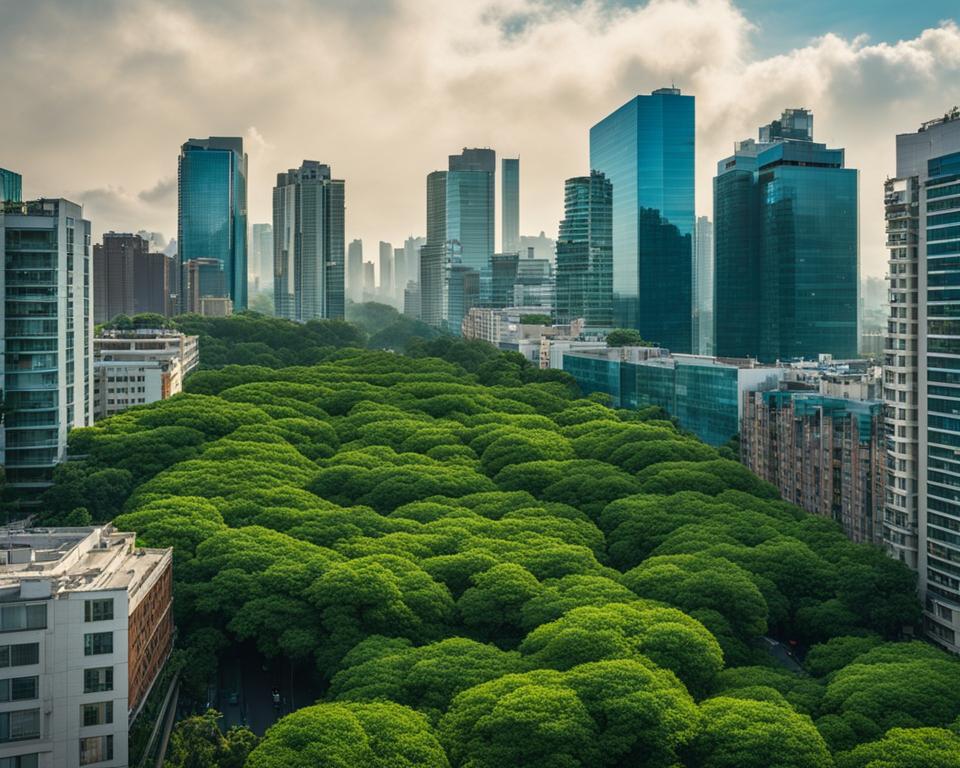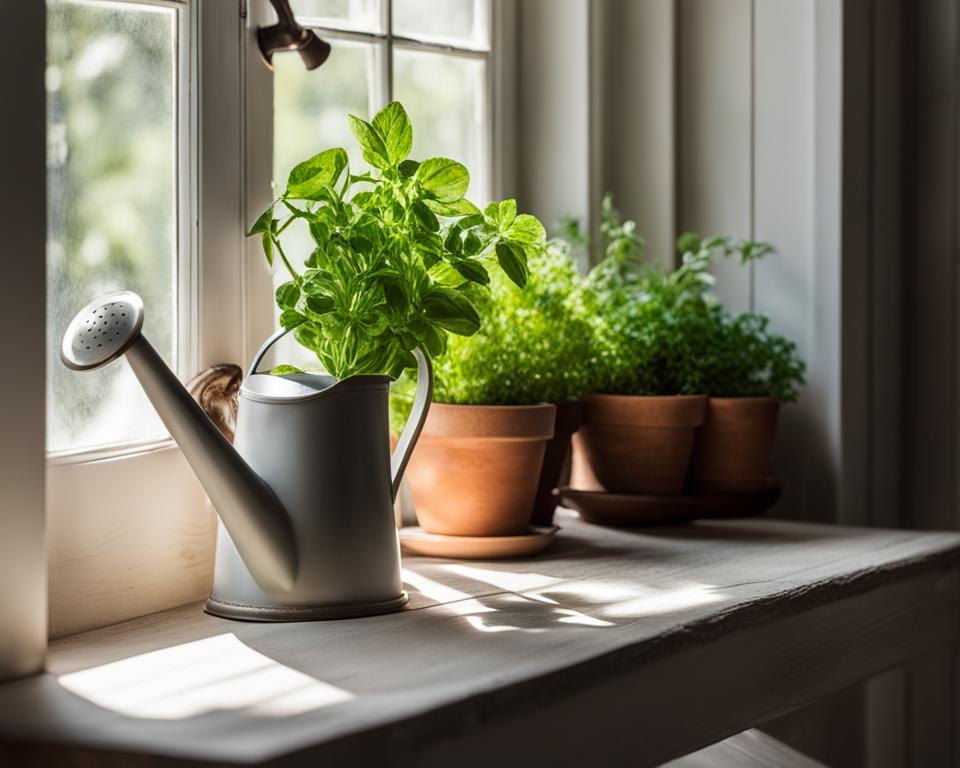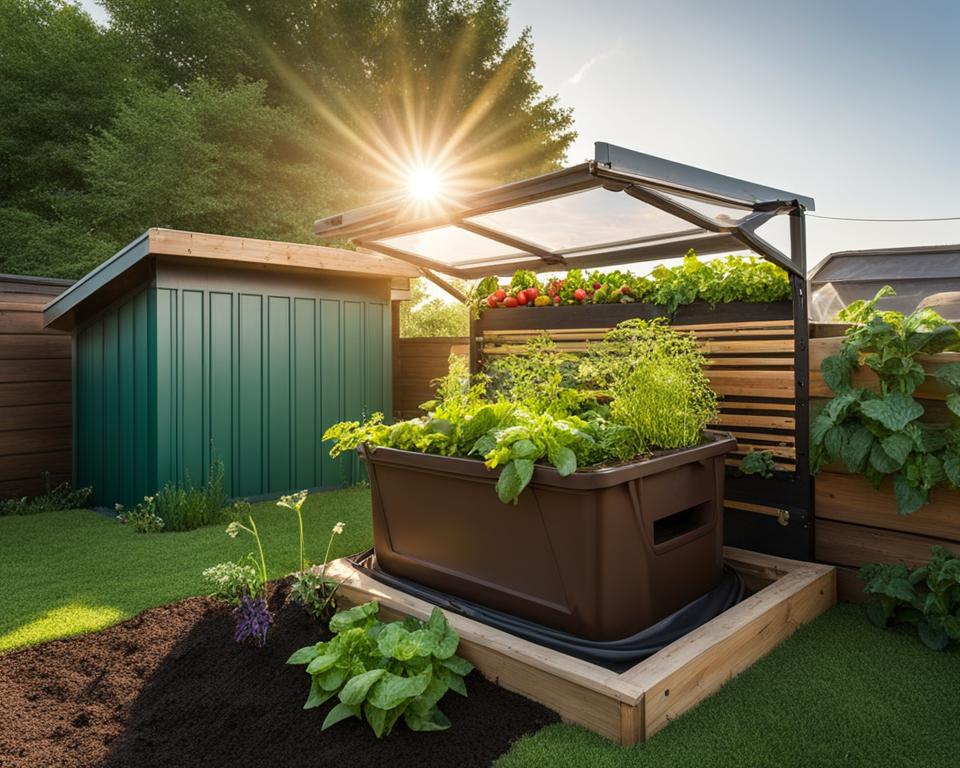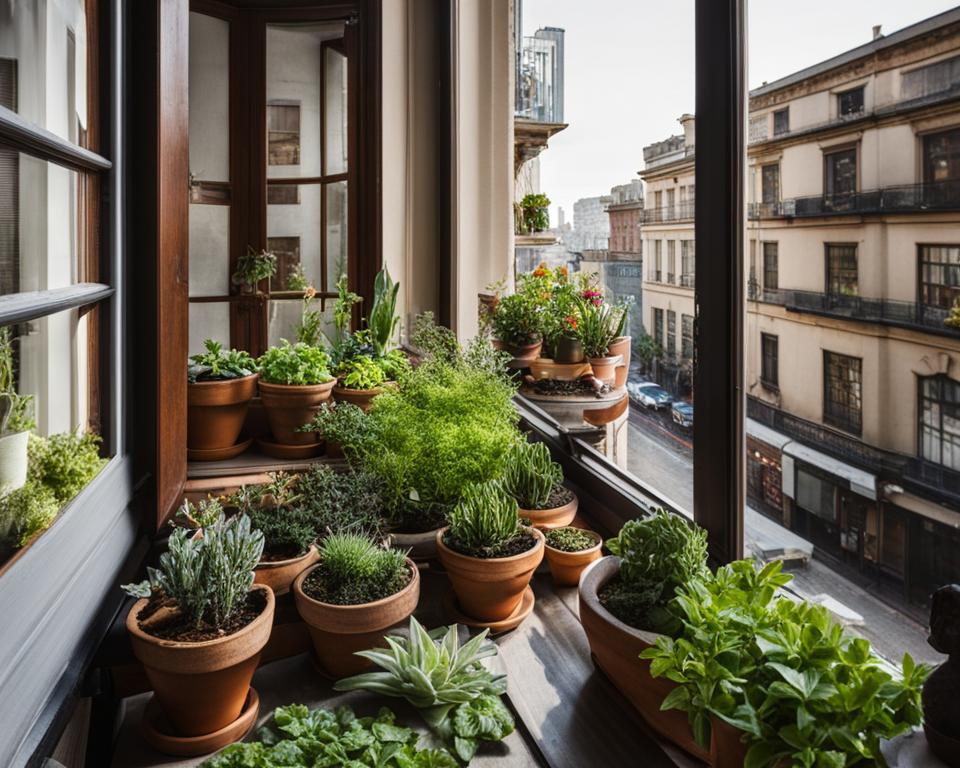Embracing urban gardening at home is more than a hobby; it’s a step towards a green lifestyle and sustainable living. Amidst the concrete and bustling streets, your willingness to engage in eco-friendly gardening brings a slice of nature into the urban jungle. Whether you’re working with a rooftop haven, cozy balcony, or just a quaint window sill, small space gardening is an empowering way to reduce your carbon footprint, contribute to local ecosystems, and cultivate fresh, organic produce for your table.
You, as an urban dweller, have the unique opportunity to transform any limited space into a green oasis. Each container of herbs, each vertical plant wall, and every organically nurtured vegetable enriches our cities with life-sustaining oxygen and a touch of verdant beauty. Ready to join the movement? Let’s grow a healthier world right from your apartment.
Key Takeaways
- Urban gardening revolutionizes eco-conscious living within city landscapes.
- Adopting green garden methods minimizes environmental impact, even in small spaces.
- Innovative techniques such as vertical planting maximize the use of limited urban areas.
- Creating organic produce at home supports sustainability and wellness.
- Contributing to the reduction of carbon emissions, urban gardens are a force for global change.
- Turning balconies and rooftops into garden spaces elevates the quality of urban life.
The Fundamentals of Urban Gardening at Home
Transform your city abode into a green sanctuary with the essentials of urban gardening at home. Delving into eco-friendly gardening is not only about beautifying your space but also about contributing positively to the environment and your wellbeing. Below, we explore the basics of this sustainable practice, its myriad benefits, and how you can get started with your first urban garden.
Understanding the Basics of Eco-Friendly Gardening
At the heart of eco-friendly gardening are methods that respect and enhance the natural environment. It’s about embracing organic gardening methods that forgo synthetic inputs for natural alternatives. Key principles include composting to enrich soil health, water conservation through smart irrigation, and selecting the right plants that thrive in your urban setting.
- Utilize natural compost made from kitchen scraps and yard waste.
- Incorporate water-saving techniques like drip irrigation and rainwater collection systems.
- Select local or native plant varieties that require less maintenance and are adapted to your climate.
Implementing these principles not only provides a haven for local flora and fauna but also ensures that your garden stays healthy and productive without imposing harm to the broader environment.
Benefits of Urban Gardening for a Sustainable Future
Gardens are more than just a source of beauty and relaxation; they are powerful tools for promoting sustainable living and reducing your carbon footprint. Your green space can serve as a mini-habitat for urban wildlife, helping to preserve biodiversity and supporting local ecosystems. Not to mention, the act of growing your own food can significantly cut down on greenhouse gas emissions associated with industrial agriculture and long-distance transportation.
By fostering plant life, urban gardeners play a critical role in cleaning the air and contributing to the urban landscape in a meaningful way.
Getting Started with Your First Urban Garden
Ready to begin your journey into urban gardening? Here’s how you can start planting and nurturing your little oasis amidst the cityscape:
- Assess Your Space: Even the smallest balcony or windowsill has potential. Note the sunlight and wind patterns, and imagine where plants could thrive.
- Choose the Right Containers: Invest in containers with good drainage and consider the size and depth needed for the roots of your chosen plants.
- Go Vertical: Create more growing space with trellises, hanging planters, and vertical wall gardens.
- Select Suitable Plants: Opt for plants that match the environmental conditions of your space and your gardening skill level.
Remember, starting small is perfectly fine. Container gardening is a flexible and forgiving way to hone your green thumb, even with limited experience. Plus, it can be incredibly rewarding as you watch your garden grow and flourish over time.
Now that you are equipped with the fundamentals of urban gardening, it’s time to get your hands dirty and experience the joy of growing your own plants. Whether it’s creating a lush green space to unwind in or cultivating fresh produce for your kitchen, your urban garden awaits your personal touch.
Urban Gardening Tips for Maximizing Limited Spaces
If you’ve been pondering over how to cultivate a lush garden within the confines of your urban dwelling, worry not. The art of maximizing limited spaces can turn even the tiniest of balconies into verdant sanctuaries. Balcony gardening, rising popularity in vertical gardens, and innovative small space gardening techniques are here to revolutionize the way we think about city gardens. Here’s how you can get started:
Maximizing vertical space is key. Instead of spreading outwards, think upwards! Vertical gardens not only save floor space but also create visually arresting green walls that can be both aesthetic and functional. Whether you’re aiming to grow herbs, flowers, or even some vegetables, the vertical plane offers an untapped canvas for your horticultural craft.
- Create pocket gardens using fabric or wooden wall-mounted planters for an instant green boost.
- Utilize sturdy shelves, tiered planters or trellises to take advantage of vertical space for growing a variety of plants.
- Recycle hanging shoe organizers as a space-saving solution to grow small plants and herbs.
Next, consider balcony gardening. Balconies are often underused, but with the right containers and plant choices, they can transform into a thriving garden spot. A combination of pots, window boxes, and railing planters can make the most of this outdoor space, regardless of its size. Additionally, incorporating elements like self-watering systems makes plant care more manageable, especially for those with busy lifestyles.
| Container Type | Best For | Features |
|---|---|---|
| Window boxes | Herbs, flowers, and trailing plants | Utilize railing space; ideal for display purposes |
| Pots and planters | Larger plants or vegetables | Portable and versatile; various sizes available |
| Railing planters | Small to medium-sized plants | Space-efficient; perfect for limited floor space |
If you worry about floor space, integrate small space gardening methods to leverage every inch of your urban area. Choose compact and dwarf plant varieties that require less room to grow. Additionally, folding furniture or stackable seating can clear space quickly for gardening tasks and then be redeployed for your relaxation afterwards.
Lastly, a wise gardener knows the importance of being strategic about their plant choices. Opt for species that serve multiple purposes—like providing shade, enhancing privacy, or producing edible fruits. Here are some examples that you can adopt for your small space gardening:
- Strawberries in hanging baskets not only save space but also add a touch of sweetness to your homegrown harvest.
- Cherry tomatoes can thrive in a vertical garden, bringing vibrant color and fresh flavor to your balcony.
- Lettuce and other leafy greens grow well in shallow containers, making them ideal choices for window boxes.
“The future of urban gardening is growing up, not out. Vertical gardens and smart use of space can transform the smallest areas into productive and enjoyable green spaces.”
Embrace the challenge of a limited area by adapting these strategies to your unique space. With creativity and the right approach, your small urban corner can become a bountiful, sustainable garden that brings joy and nature into your home.
Choosing the Right Plants for Your Urban Oasis

When you decide to cultivate an urban garden, choosing the right plants is crucial for both aesthetics and environmental impact. This selection is not just about personal preference—it’s about making a positive contribution to CO2 reduction and creating a thriving ecosystem right in your urban space.
Best Trees for Reducing CO2 in Urban Settings
To address urban air quality and climate change, selecting the “Best Trees for Reducing CO2” is a high-impact strategy. These are usually the species that grow large, have long lifespans, and therefore have the capacity to store significant amounts of carbon over time:
- Oaks (Quercus spp.) – Their dense wood and expansive canopies make them exceptional at sequestering carbon.
- Maples (Acer spp.) – Besides offering beautiful fall colors, maples also play a substantial role in carbon capture.
- Lindens (Tilia spp.) – With a rapid growth rate and large leaves, lindens are effective urban trees for CO2 absorption.
- Elms (Ulmus spp.) – Hardy and tolerant of pollution, elms are suitable for urban environments.
- Pines (Pinus spp.) – Evergreen and resilient, pines provide year-round CO2 reduction benefits.
Such trees are not only attractive and manageable within urban constraints but also champions of carbon sequestration. Be sure to choose varieties native or well-adapted to your local weather and soil conditions for best results.
Selecting Fruits and Vegetables for Urban Garden Conditions
In the urbanscape, you can nurture a fruitful garden by choosing vegetables and fruits that are resilient and adaptable to varied conditions, such as limited sunlight and space. Here is an introduction to some of the best contenders for your garden:
| Plant | Benefits | Conditions |
|---|---|---|
| Tomatoes | High yield in small spaces | At least 6 hours of sun |
| Strawberries | Can be grown in vertical planters | Well-drained, fertile soil |
| Herbs (Basil, Parsley, Cilantro) | Ideal for window boxes | Full sun to part shade |
| Kale | Tolerant to cold and heat | Rich, well-draining soil |
| Peppers | Thrives in pots and containers | Warm, sunny spot |
Using coir-based compost and organic growing methods, such plants can flourish even in confined spaces, reducing the need for long transport distances and thereby cutting down on carbon emissions.
Decorative Plants That Thrive in Urban Environments
Decorative plants add color, texture, and life to your urban space. Here are a few varieties that are not only pleasing to the eye but also resilient enough to withstand urban conditions:
- Lavender – Known for its fragrance, lavender is drought-resistant and requires minimal care.
- Ornamental Grasses – These bring a contemporary aesthetic and are adaptable to various urban conditions.
- Geraniums – With vibrant blooms, geraniums are excellent for containers and can endure urban pollution.
Beautifying your space with plants that are adapted to urban environments not only creates a tranquil retreat but also contributes to the local ecosystem and air quality.
Embrace your role as an urban gardener and transform your home into a green refuge that supports CO2 reduction and sustainable living. By making informed choices about the trees, produce, and decorative plants in your urban oasis, you build a more resilient and visually enchanting space—one that both nourishes you and protects the environment.
Indoor Gardening: Bringing Nature into Your Home

As an oasis of tranquility and greenery, indoor gardening elevates the aesthetic and atmosphere of your living space. With vibrant indoor plants and a flourishing indoor herb garden, you invite nature indoors, intertwining the essence of the great outdoors with modern home life. In this section, discover the joys and benefits of establishing your private green retreat and how it contributes to a cleaner and more refreshing home environment.
Creating an Indoor Herb Garden
In the realm of indoor gardening, curating an indoor herb garden is a delightful way to introduce freshness and flavor into your kitchen. No matter the season, these aromatic plants, from the sweet scent of basil to the cool burst of mint, stand ready to enhance your culinary creations.
- Accessible fresh herbs for cooking, directly from your window sill
- A joyful activity that connects you with nature
- Create a beautiful, living decor piece that enlivens your home
Herbs such as basil, mint, and cilantro are renowned for their low-maintenance care, requiring just a touch of sunlight and a sip of water. As you drift into the world of home gardening, these herbaceous companions will provide continuous satisfaction with their delightful presence and delectable contributions to your meals.
Nothing compares to the satisfaction of snipping fresh herbs from your personal garden and directly enhancing your home-cooked meals with their flavors.
The Role of Indoor Plants in Improving Air Quality
Beyond contributing to the visual beauty of your home, indoor plants serve a pivotal role in purifying the air you breathe. These silent guardians filter common urban pollutants, releasing oxygen and fostering a healthier indoor environment.
- Spider Plant (Chlorophytum comosum): A champion in removing formaldehyde and other toxins.
- Snake Plant (Sansevieria trifasciata): Known for its air-purifying capabilities, especially at night.
- Aloe Vera: Not only medicinal, but also efficient in filtering various contaminants.
Such plants are especially adept at creating an oasis of fresh air within the confines of an urban setting. Breathing life into corners and crannies, they transform your home into a healthful sanctuary. For an array of benefits that encompass mood enhancement, stress reduction, and aesthetic appeal, consider integrating these purifying species into your urban gardening tips repertoire.
| Plant | Air Purifying Quality | Ease of Care |
|---|---|---|
| Peace Lily (Spathiphyllum) | Effectively removes airborne toxins | Low; thrives in shady, humid conditions |
| Boston Fern (Nephrolepis exaltata) | Excels in humidifying the air | Moderate; prefers moist soil and indirect light |
| Golden Pothos (Epipremnum aureum) | Targets formaldehyde and other VOCs | Easy; resilient, even in lower light |
Embody the essence of home gardening with only a handful of seeds and a pot; the transformation they’ll ignite in your home reaches beyond their physical beauty. By cultivating a spot of greenery indoors, you contribute to the 6 fundamental advantages of indoor gardening: aesthetics, air quality, wellness, education, culinary delights, and ecological responsibility. Embark on this journey and witness how a modest indoor garden can grow into a fulfilling and enriching endeavor.
Implementing Eco-friendly Gardening Techniques

Adopting eco-friendly gardening techniques is a transformative approach to ensuring your garden not only thrives but does so responsibly, respecting the planet. Embracing principles such as using organic compost and prioritizing soil health can lead to a flourishing garden ecosystem that requires fewer chemical interventions and is resilient in the face of changing environmental conditions. Let’s delve into some sustainable practices you can initiate right away.
Every act of eco-friendly gardening is a step towards a healthier planet. By nurturing the soil and the life within it, we become stewards of a more sustainable future.
Composting: The Heart of Organic Gardening
Begin with organic compost, the cornerstone of eco-friendly gardening. Compost enriches the soil, introduces beneficial microorganisms, and helps retain moisture — all while recycling kitchen and yard waste. Here’s how you can get started:
- Create a compost bin or pile in a convenient spot in your yard.
- Add equal parts of ‘greens’ (kitchen scraps) and ‘browns’ (dry leaves, shredded paper) to maintain balance.
- Regularly turn your compost to aerate and speed up the decomposition process.
- Use this black gold to enrich your garden beds, boosting plant health and vitality.
Natural Pest Control
Replacing chemical pesticides with natural alternatives helps maintain an organic balance within your garden. Consider these methods:
- Introduce beneficial insects like ladybugs and lacewings that prey on harmful pests.
- Plant marigolds, garlic, or chives to deter pests with their natural aromas.
- Use non-toxic homemade sprays, such as soap and water, to manage infestations.
Crop Rotation: Key to Soil Health
To prevent soil depletion, practice crop rotation. This age-old technique involves changing the types of crops grown in each section of your garden from year to year. Benefits include:
- Reducing the risk of soil-borne diseases
- Managing nutrient levels in the soil
- Breaking pest and disease life cycles
| Year 1 | Year 2 | Year 3 |
|---|---|---|
| Legumes (Beans, Peas) | Roots (Carrots, Beets) | Leafy Greens (Lettuce, Spinach) |
| Roots (Carrots, Beets) | Leafy Greens (Lettuce, Spinach) | Fruiting (Tomatoes, Peppers) |
| Leafy Greens (Lettuce, Spinach) | Fruiting (Tomatoes, Peppers) | Legumes (Beans, Peas) |
As you advance in your eco-friendly gardening journey, consider integrating more advanced methods such as mulching and water conservation techniques. Mulching reduces water loss, suppresses weeds, and slowly enriches the soil as it decomposes. Collecting rainwater in barrels for irrigation purposes can also have a significant impact on your garden’s ecological footprint.
Your commitment to eco-friendly gardening is powerful. By focusing on organic compost, nurturing soil health, and employing natural practices, not only will your garden flourish, but you’ll also contribute to the wellbeing of the wider environment. Remember, each individual effort counts towards creating a greener, more sustainable world.
Transforming Your Balcony into a Productive Garden
Looking to make the most out of your balcony space in the urban jungle? Container gardening and savvy layout designs can morph your balcony into a charming and productive garden. Dive into these valuable best practices that cover everything from picking the right containers to arranging your greenery for maximum impact.
Container Gardening: Best Practices and Innovative Ideas
Container gardening is a flexible solution for space-starved gardeners, allowing you to enjoy a splash of nature right on your balcony. To ensure success, here’s what you need to keep in mind:
- Select containers that complement the size of the plants you wish to grow. Ensure they afford enough room for the roots to expand.
- Good drainage is crucial. Opt for pots with adequate drainage holes to prevent water-logging.
- Choose the right soil mix for your plants, and be attentive to their nutritional needs for a thriving garden.
Innovations like self-watering containers streamline the care process and are ideal for those with busy schedules. Vertical planters also offer an attractive and space-saving solution to growing more in less space. With these tips, even novices can enjoy the marvels of balcony gardening with ease.
Balcony Gardening: Design and Layout Tips
When planning your urban oasis, consider both aesthetics and functionality. The following layout tips can help turn your balcony into a green paradise:
- Use hanging plants to create a lush, layered look without sacrificing floor space.
- Invest in tiered plant stands that allow for the display of multiple plants in an organized manner.
- Modular planters and adjustable railing pots offer great flexibility and can be tailored perfectly to your balcony’s specific dimensions.
Create a cohesive design by grouping similar colors and textures. Here’s an example of a layout design to get started:
| Section | Plant Type | Container Type | Sunlight Needs |
|---|---|---|---|
| Left Corner | Herbs (Basil, Cilantro) | Hanging Baskets | Full Sun |
| Right Corner | Flowering Plants (Petunias, Geraniums) | Window Boxes | Partial Sun |
| Center | Vegetables (Cherry Tomatoes, Peppers) | Vertical Planter | Full Sun |
With your gardening strategy set and the beauty of nature at your fingertips, sit back and enjoy the view as your balcony gardening efforts bloom before your eyes. Remember, gardening is not just an activity; it’s an 8-fold path to a healthier lifestyle and urban environment.
Conclusion
Embarking on the journey of urban gardening at home is an enriching endeavor that taps into the core values of a green lifestyle and sustainable living. Throughout this guide, we’ve explored numerous strategies and practices that empower you to make a positive environmental impact right where you live. Recognizing the power inherent in cultivating plants, you become part of a movement that contributes to cleaner air, enhanced biodiversity, and a more sustainable future for urban communities.
Your role as an urban gardener is significant; converting balconies into productive gardens, embracing indoor herb cultivation, and applying eco-friendly gardening techniques are transformative actions. As you integrate these aspects into your daily life, you connect deeply with nature, fostering well-being for yourself and those around you. Always remember, even the smallest patch of greenery contributes to the grand tapestry of life, and your efforts in sustainable living resonate beyond the boundaries of your garden.
In summary, urban gardening at home goes beyond mere cultivation – it’s a means to reconnect with the environment, promote a green lifestyle, and support sustainable living practices that ripple out into the community. Whether you’re growing herbs on a sunny windowsill or transforming a small patio into a verdant retreat, each step you take is one closer to a greener, more sustainable world. The seeds of change are in your hands; nurture them, and watch a greener future grow before your eyes.
FAQ
What is urban gardening at home?
Urban gardening at home refers to the practice of cultivating plants in an urban environment, such as in a small backyard, on a balcony, or indoors. It’s a way to embrace a green lifestyle and engage in sustainable living by growing your own fruits, vegetables, and decorative plants within limited urban spaces.
How does eco-friendly gardening benefit the environment?
Eco-friendly gardening reduces your carbon footprint by avoiding the use of synthetic fertilizers and pesticides, conserving water, and using organic compost. It creates habitats for local wildlife, supports biodiversity, and helps in reducing air and soil pollution.
Can I start an urban garden if I have no previous experience?
Absolutely! You can start an urban garden even without prior experience. Begin with research on organic gardening methods, select easy-to-grow plants, and use space-saving techniques like container and vertical gardening to make the most of small spaces. Conserving water through methods like drip irrigation can also play a significant part in your gardening journey.
What are some tips for gardening in limited urban spaces?
To maximize limited urban spaces, consider balcony gardening, using vertical gardens, hanging planters, and tiered stands to grow upwards. Opt for compact plant varieties and ensure each plant receives adequate sunlight and water. Using mirrors can increase light in darker corners, and foldable furniture can save space.
How do I choose the right plants for urban gardening?
Select plants based on the sunlight, space, and air quality available in your urban setting. For reducing CO2 levels, choose tree species that excel at carbon sequestration. Pick fruits and vegetables that can thrive in your specific conditions, and for ornamental purposes, choose plants that are resilient to pollution and space constraints.
What are some ideal plants for an indoor herb garden?
Herbs that grow well indoors include basil, mint, cilantro, rosemary, and thyme. They generally require relatively less space and can thrive with adequate sunlight and regular watering. They not only add fresh flavors to your meals but also bring greenery to your living space.
How do indoor plants improve air quality?
Many indoor plants act as natural air purifiers, absorbing toxins and emitting oxygen. They can help filter out volatile organic compounds (VOCs) and increase humidity levels, improving overall air quality in your home. Spider plants, snake plants, and peace lilies are particularly effective for this purpose.
What are some eco-friendly gardening techniques?
Eco-friendly gardening techniques include composting kitchen scraps to create nutrient-rich soil, using natural pest control methods, practicing crop rotation, and employing water conservation strategies such as mulching and using rain barrels. These practices promote a sustainable garden by improving soil health and reducing waste.
What are some best practices for container gardening?
Best practices for container gardening include choosing containers with adequate drainage, using high-quality potting mix, ensuring pots are the right size for the plants, and choosing plant varieties well-suited to container life. Innovations like self-watering planters and sub-irrigation systems can help maintain moisture levels and promote healthy plant growth.
How should I design and layout my balcony garden?
When designing your balcony garden, consider the amount of sunlight your space gets and choose plants accordingly. Create a layout that allows for proper plant spacing and air circulation. Utilize vertical space with hanging baskets and wall planters, and choose furniture that is proportional to your space to avoid overcrowding. Integrating plants of different heights and textures can also add visual interest to your balcony garden.

